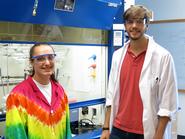
Enzymes and proteins, typically when left unattended or unprotected, can easily lose their structural integrity and fall apart. Sol-Gel is an emerging material that helps encapsulate the enzymes and protect them from the dangers of degradation. The technology can be used in numerous applications, one of them being a new method for slow-release medications. These slow release medicines allow for the introduction of necessary chemicals over a period of time, avoiding any negative side effects from releasing all the medication at once.
Ashleigh Stephan ’15 and Jacob Wagner ’15 will work with Professor of Chemistry Tim Elgren to study amine oxidase within the gels. Amine oxidase has a vast array of functions, one of the most important being cell signaling to respond to different stimuli in the body. The sol gel is unique and useful because it can encase a complete protein and maintain its enzymatic function.
A substrate is an object or solution that an enzyme can react with. Amplex Red, a marketed substrate, can detect and measure the slightest presence of the enzyme horseradish peroxidase (HRP). The group is starting with this well-studied enzyme, and linking it to their protein of interest, amine oxidase. Once the two enzymes are linked, they can use HRP as a signaling protein in the gel and environments in order to detect the activity of the enzymes. Any activation of amine oxidase will be mirrored in HRP activity and can thus be measured with the Amplex Red.
The gel containing chosen enzymes can be extremely useful in lab applications. Amine oxidase plays a central role in certain metabolic pathways in the body and has other important physiological functions. Sol gel will be able to take enzymes like this and introduce them to different environments, like those with various pH levels, and see how the reagents behave. The group can also create gels that only allow certain compounds to permeate the matrix and create selective reactions.
Both Wagner and Stephan knew they were interested in the sciences and began pursuing a pre-medical route at the beginning of their college careers. Students in past years had worked with Elgren in order to solidify a procedure to create the gels, and they confirmed that enzymes maintained their functions once encapsulated. This group is now repeating the procedure to produce the gels and trying to couple enzymes to act as the signals.
The group must use extreme care over the course of the summer. Tetramethoxysilane (TMOS) will be present in their lab and is necessary for certain procedures with the Sol Gel. This chemical is also one of the most hazardous ones used in the Science Building. Should the chemical come in contact with any mucus membrane, for example in the eyes or lungs, it will hydrolyze the membrane into silica, or essentially glass. This reaction could lead to serious harm.
Wagner and Stephan will also utilize multiple electronic tools in the lab. One of the “neatest,” according to Wagner, is the sonicator. This machine can evenly distribute or break down molecules in a substance by manipulating sound waves. The group will also take advantage of the flurometer, a tool that is not frequently used in the science departments. The fluorometer offers more precise fluorescence readings than a spectrophotometer, which will also be necessary to measure the concentrations of HRP or amino oxidase with the Amplex Red. The group is looking forward to reinforcing the techniques they learned in biochemistry and gaining further experience that will be valuable in graduate school.
Both Stephan and Wagner are avid participants on intramural sports teams during the academic year. Wagner, a biology major, is also a member of the men’s crew team and a teaching assistant for the biology department. Stephan, who is pursuing a concentration in chemistry, is a member of the women’s lacrosse team and also works in the athletic trainer’s office.
Jacob Wagner is a graduate of Milton High School in Milton, Ga., and Ashleigh Stephan graduated from The Ethel Walker School in Simsbury, Conn.
Posted June 12, 2013
